Effects of Microstructure on the Low-Temperature Toughness of an X80 × D1422 mm Heavy-Wall Heat-Induced Seamless Bend
Abstract
:1. Introduction
2. Experiment
2.1. Materials and the Heat-Induced Bending Process
2.2. Testing the Mechanical Properties
2.3. Microstructure Analysis
3. Results
3.1. Microstructure Properties
3.2. Mechanical Properties
3.3. Impact Toughness and Fracture Morphology
3.4. Grain Orientation Image Maps and Grain Boundary Misorientation Distribution
4. Discussion
4.1. Effect of the High-Angle Grain Boundary on Crack Propagation
4.2. Effect of Efficient Grain Size on Toughness
4.3. The Relationship between the Microstructure and he Micromechanism of Cleavage Fracture
5. Conclusions
Author Contributions
Funding
Institutional Review Board Statement
Informed Consent Statement
Data Availability Statement
Conflicts of Interest
References
- Sharma, S.K.; Maheshwari, S. A review on welding of high strength oil and gas pipeline steels. J. Nat. Gas Sci. Eng. 2017, 38, 203–217. [Google Scholar] [CrossRef]
- Zhao, M.-C.; Yang, K.; Shan, Y. The effects of thermo-mechanical control process on microstructures and mechanical properties of a commercial pipeline steel. Mater. Sci. Eng. A 2002, 335, 14–20. [Google Scholar] [CrossRef]
- Bott, I.; Souza, L.; Teixeira, J.; Rios, P.R. High-strength steel development for pipelines: A brazilian perspective. Metall. Mater. Trans. A 2005, 36, 443–454. [Google Scholar] [CrossRef]
- Wang, X.; Zhou, J.; Liang, Q. Multi-objective optimization of medium frequency induction heating process for large diameter pipe bending. Procedia Eng. 2014, 81, 2255–2260. [Google Scholar]
- Kathayat, T.S.; Hill, R.T.; Goyal, R.K.; Dhar, S. Behaviour of Mechanical Properties of High Wall Thickness and Grade in Hot Induction Bending. In Proceedings of the Offshore Technology Conference, Houston, TX, USA, 30 April–3 May 2012. 22906. [Google Scholar]
- Wang, X.; Xiao, F.-R.; Fu, Y.-H.; Chen, X.-W.; Liao, B. Material development for grade X80 heavy-wall hot induction bends. Mater. Sci. Eng. A 2011, 530, 539–547. [Google Scholar] [CrossRef]
- Wang, B.; Wang, L.; Jiang, Y.; Xu, M.; Lei, B.-B.; Hu, Y.; Wu, D.; Luo, Z.; Liu, L. Microstructure and Mechanical Behavior of X90 Bend Using Local Induction Bending. Trans. Indian Inst. Met. 2016, 70, 115–124. [Google Scholar] [CrossRef]
- Wang, Z.T.; Zhong, H. Theory of pipe-bending to a small bend radius using induction heating. J. Mater. Process. Technol. 1990, 21, 275–284. [Google Scholar]
- Wang, X.; Liao, B.; Wu, D.-Y.; Han, X.-L.; Zhang, Y.-S.; Xiao, F.-R. Effects of Hot Bending Parameters on Microstructure and Mechanical Properties of Weld Metal for X80 Hot Bends. J. Iron Steel Res. Int. 2014, 21, 1129–1135. [Google Scholar] [CrossRef]
- Zhao, Y.; Xu, S.; Li, J.; Zhang, J.; Sun, L.; Chen, L.; Sun, G.; Peng, S.; Zhang, Z. Enhancement of low temperature toughness of nanoprecipitates strengthened ferritic steel by delamination structure. Mater. Sci. Eng. A 2017, 691, 162–167. [Google Scholar] [CrossRef]
- Powar, A.; Gujar, A.; Manthani, N.; Pawar, V.; Singh, R. Effect of Secondary Phase Precipitation on Impact Toughness of Duplex Stainless Steel. Mater. Sci. Forum 2017, 889, 138–142. [Google Scholar] [CrossRef]
- Gao, G.; Zhang, H.; Gui, X.; Luo, P.; Tan, Z.; Bai, B. Enhanced ductility and toughness in an ultrahigh-strength Mn–Si–Cr–C steel: The great potential of ultrafine filmy retained austenite. Acta Mater. 2014, 76, 425–433. [Google Scholar] [CrossRef]
- Huda, N.; Midawi, A.; Gianetto, J.A.; Gerlich, A.P. Continuous cooling transformation behaviour and toughness of heat-affected zones in an X80 line pipe steel. J. Mater. Res. Technol. 2021, 12, 613–628. [Google Scholar] [CrossRef]
- Thompson, A.W.; Knott, J.F. Micromechanisms of brittle fracture. Metall. Trans. A 1993, 24, 523–534. [Google Scholar] [CrossRef]
- Bouyne, E.; Flower, H.M.; Lindley, T.C.; Pineau, A. Use of EBSD technique to examine microstructure and cracking in a bainitic steel. Scr. Mater. 1998, 39, 295–300. [Google Scholar] [CrossRef]
- Fairchild, D.P.; Howden, D.G.; Clark, W. The mechanism of brittle fracture in a microalloyed steel: Part I. Inclusion-induced cleavage. Metall. Mater. Trans. A 2000, 31, 641–652. [Google Scholar] [CrossRef]
- Zhao, Y.; Tong, X.; Wei, X.H.; Xu, S.S.; Lan, S.; Wang, X.L.; Zhang, Z.W. Effects of microstructure on crack resistance and low-temperature toughness of ultra-low carbon high strength steel. Int. J. Plast. 2019, 116, 203–215. [Google Scholar] [CrossRef]
- Lan, L.; Qiu, C.; Zhao, D.; Gao, X.; Du, L. Microstructural characteristics and toughness of the simulated coarse grained heat affected zone of high strength low carbon bainitic steel. Mater. Sci. Eng. A 2011, 529, 192–200. [Google Scholar] [CrossRef]
- Zhou, T.; Yu, H.; Hu, J.; Wang, S. Study of microstructural evolution and strength–toughness mechanism of heavy-wall induction bend pipe. Mater. Sci. Eng. A 2014, 615, 436–446. [Google Scholar] [CrossRef]
- Wang, H.B.; Wang, F.L.; Shi, G.H.; Sun, Y.; Liu, J.C.; Wang, Q.F.; Zhang, F.C. Effect of welding heat input on microstructure and impact toughness in CGHAZ of X100Q steel. J. Iron Steel Res. Int. 2019, 26, 637–646. [Google Scholar] [CrossRef]
- Wang, H.; Wang, F.; Shi, G.; Sun, Y.; Liu, J.; Wang, Q.; Zhang, F. Effect of quenching temperature on microstructure and yield strength of Q-T-treated X100Q bainitic steel. Mater. Res. Express 2018, 5, 066509. [Google Scholar] [CrossRef]
- Godefroid, L.B.; Sena, B.M.; Trindade Filho, V.B.D. Evaluation of Microstructure and Mechanical Properties of Seamless Steel Pipes API 5L Type Obtained by Different Processes of Heat Treatments. Mater. Res. 2017, 20, 514–522. [Google Scholar] [CrossRef] [Green Version]
- Sakai, Y.; Tamanoi, K.; Ogura, N. Application of tanh curve fit analysis to fracture toughness data of Japanese RPVS. Nucl. Eng. Des. 1989, 115, 31–39. [Google Scholar] [CrossRef]
- Cvetkovski, S. Instrumented testing of simulated Charpy specimens made of microalloyed MnNiV steel. Eur. Struct. Integr. Soc. 2002, 30, 95–102. [Google Scholar]
- Thompson, S.W. Interrelationships between yield strength, low-temperature impact toughness, and microstructure in low-carbon, copper-precipitation-strengthened, high-strength low-alloy plate steels. Mater. Sci. Eng. A 2018, 711, 424–433. [Google Scholar] [CrossRef]
- Tanguy, B.; Besson, J.; Piques, R.; Pineau, A. Ductile to brittle transition of an A508 steel characterized by Charpy impact test: Part II: Modeling of the Charpy transition curve. Eng. Fract. Mech. 2005, 72, 413–434. [Google Scholar] [CrossRef] [Green Version]
- Niels, H. Hall-Petch relation and boundary strengthening. Scr. Mater. 2004, 51, 801–806. [Google Scholar]
- Wang, C.; Wang, M.; Shi, J.; Hui, W.; Dong, H. Effect of microstructural refinement on the toughness of low carbon martensitic steel. Scr. Mater. 2008, 58, 492–495. [Google Scholar] [CrossRef]
- Kitahara, H.; Ueji, R.; Tsuji, N.; Minamino, Y. Crystallographic features of lath martensite in low-carbon steel. Acta Mater. 2006, 54, 1279–1288. [Google Scholar] [CrossRef]
- Miyamoto, G.; Iwata, N.; Takayama, N.; Furuhara, T. Mapping the parent austenite orientation reconstructed from the orientation of martensite by EBSD and its application to ausformed martensite. Acta Mater. 2010, 58, 6393–6403. [Google Scholar] [CrossRef]
- Wang, C.; Qiu, H.; Kimura, Y.; Inoue, T. Morphology, crystallography, and crack paths of tempered lath martensite in a medium-carbon low-alloy steel. Mater. Sci. Eng. A 2016, 669, 48–57. [Google Scholar] [CrossRef]
- Kitahara, H.; Ueji, R.; Ueda, M.; Tsuji, N.; Minamino, Y. Crystallographic analysis of plate martensite in Fe–28.5 at.% Ni by FE-SEM/EBSD. Mater. Charact. 2005, 54, 378–386. [Google Scholar] [CrossRef]
- Pineau, A.; Benzerga, A.A.; Pardoen, T. Failure of metals I: Brittle and ductile fracture. Acta Mater. 2016, 107, 424–483. [Google Scholar] [CrossRef] [Green Version]
- Pineau, A. Development of the Local Approach to Fracture over the Past 25 years: Theory and Applications. Int. J. Fract. 2006, 138, 139–166. [Google Scholar] [CrossRef]
- Griffiths, J.R.; Owen, D. An elastic-plastic stress analysis for a notched bar in plane strain bending. J. Mech. Phys. Solids 1971, 19, 419–431. [Google Scholar] [CrossRef]
- Dáz-Fuentes, M.; Iza-Mendia, A.; Gutiérrez, I. Analysis of different acicular ferrite microstructures in low-carbon steels by electron back scattered diffraction. Study of their toughness behavior. Metall. Mater. Trans. A 2003, 34, 2505–2516. [Google Scholar] [CrossRef]
- Lu, J.; Yu, H.; Yang, S.F. Mechanical behavior of multi-stage heat-treated HSLA steel based on examinations of microstructural evolution. Mater. Sci. Eng. A 2021, 803, 140493. [Google Scholar] [CrossRef]
- Knott, J.F. Local approach concepts and the microstructures of steels. Eng. Fract. Mech. 2008, 75, 3560–3569. [Google Scholar] [CrossRef]
- Margolin, B.Z.; Shvetsova, V.A.; Karzov, G.P. Brittle fracture of nuclear pressure vessel steels—I. Local criterion for cleavage fracture. Int. J. Press. Vessel. Pip. 1997, 72, 73–87. [Google Scholar] [CrossRef]
- Lambert-Perlade, A.; Sturel, T.; Gourgues, A.; Besson, J.; Pineau, A. Mechanisms and modeling of cleavage fracture in simulated heat-affected zone microstructures of a high-strength low alloy steel. Metall. Mater. Trans. A 2004, 35, 1039–1053. [Google Scholar] [CrossRef]
- Chen, J.H.; Wang, G.Z.; Wang, Q. Change of critical events of cleavage fracture with variation of microscopic features of low-alloy steels. Metall. Mater. Trans. A 2002, 33, 3393–3402. [Google Scholar] [CrossRef]

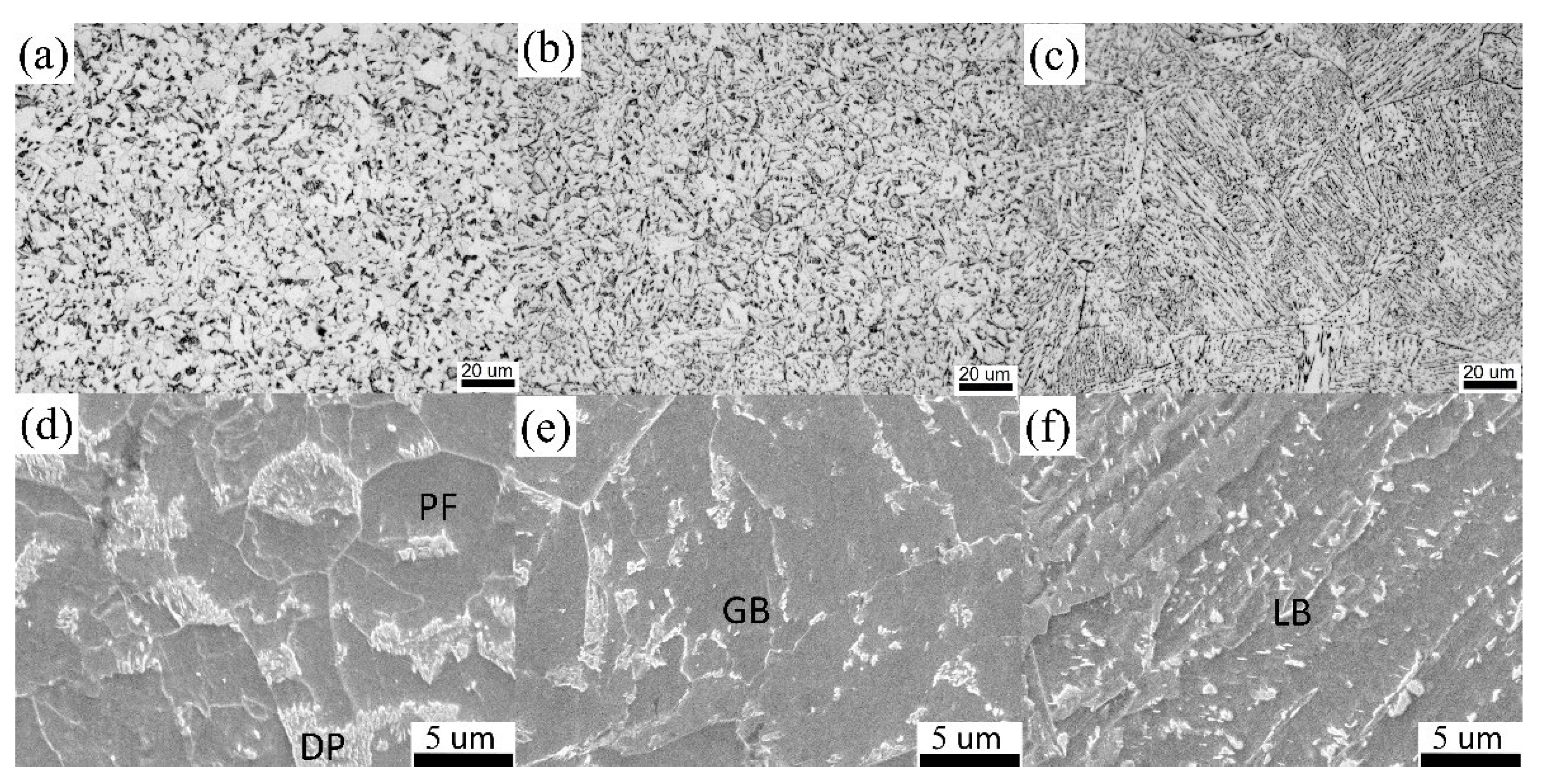

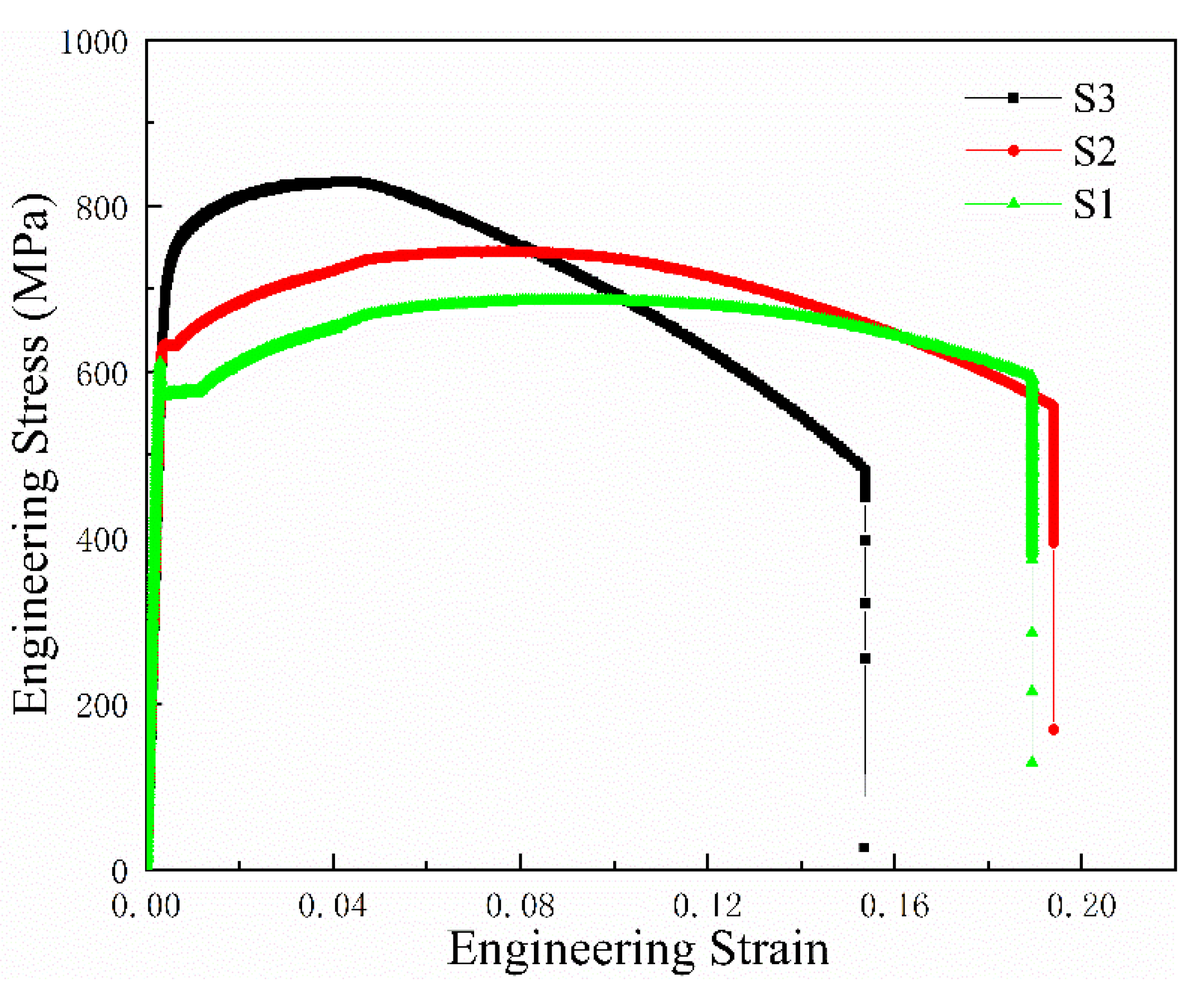
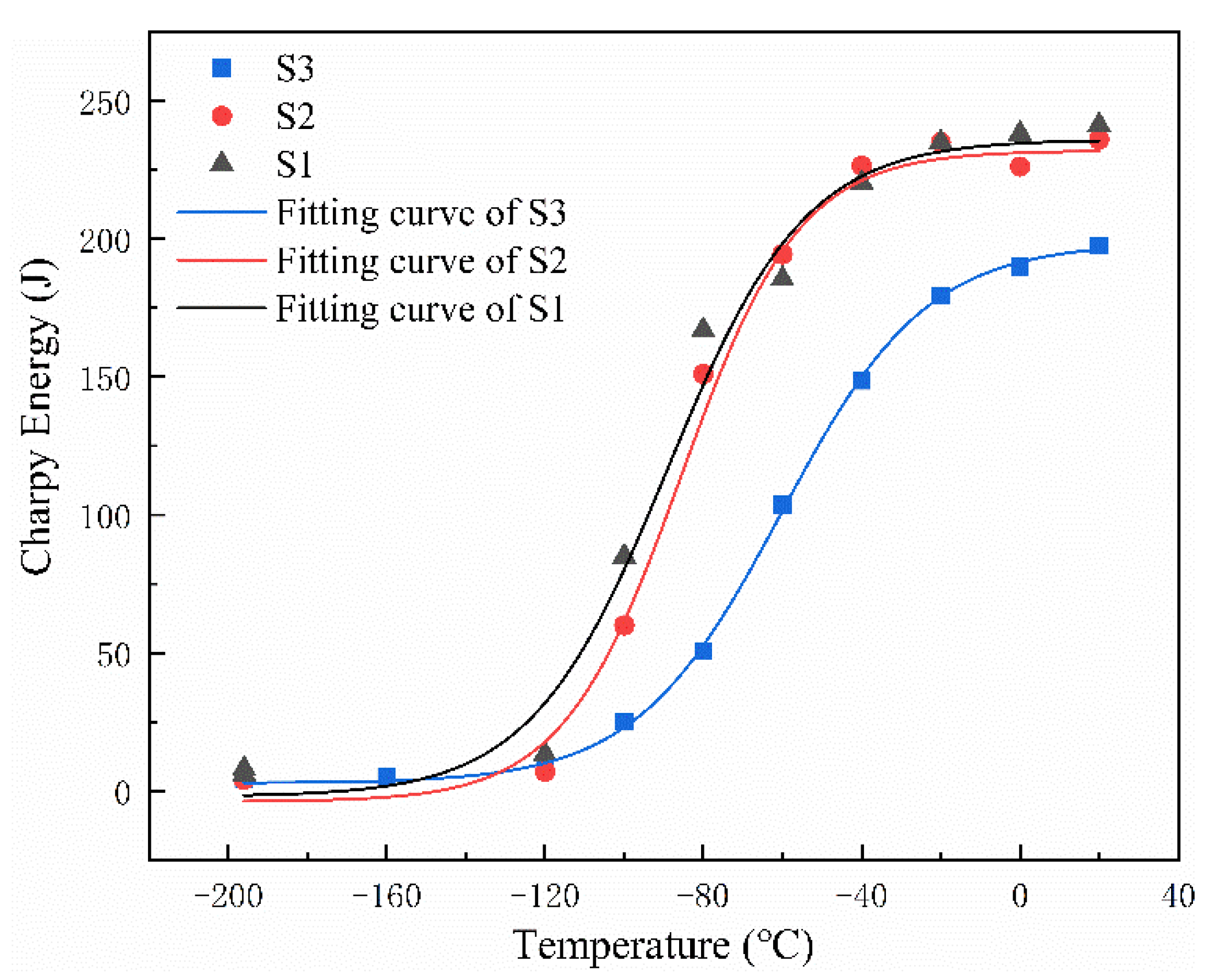
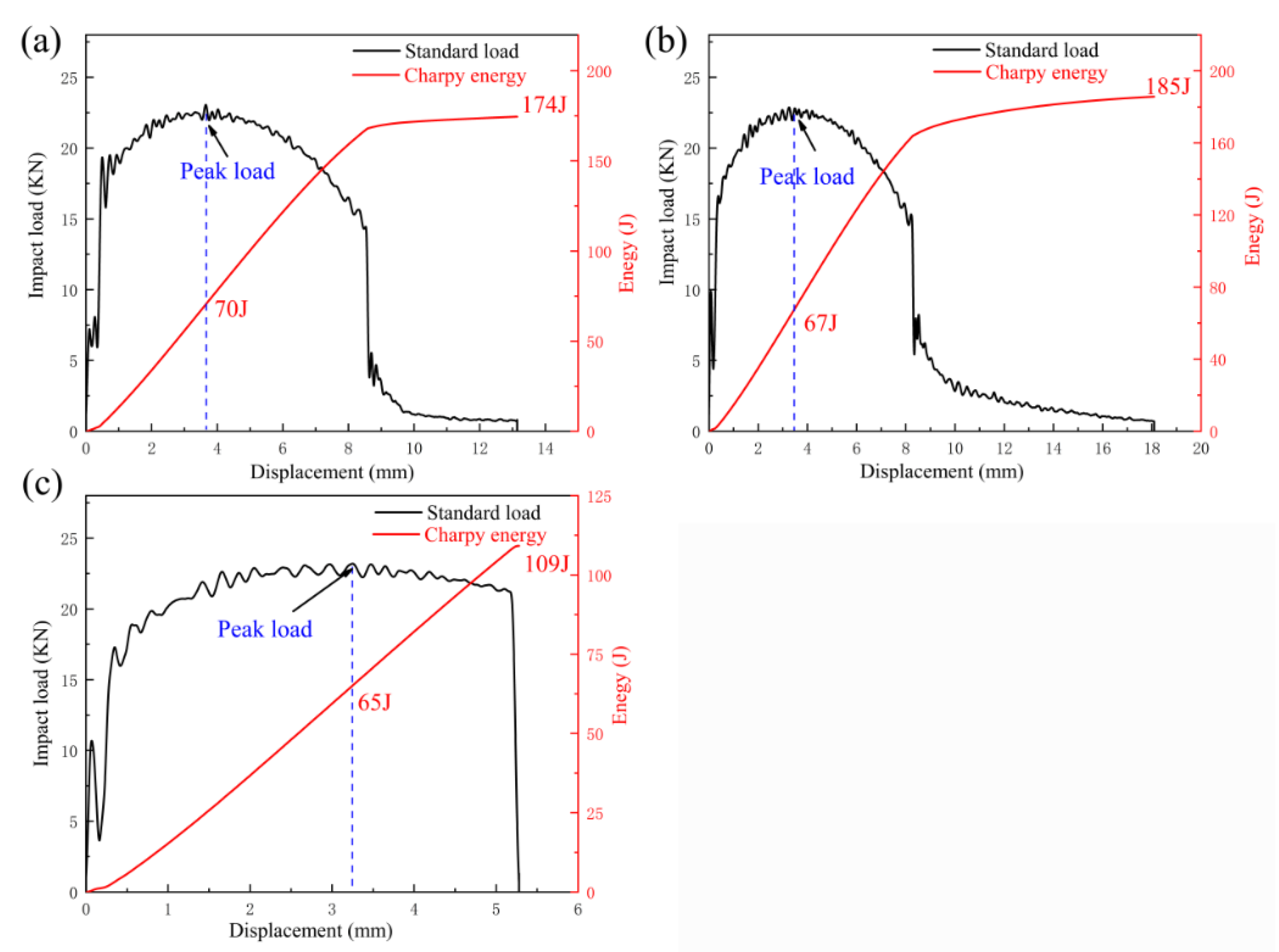
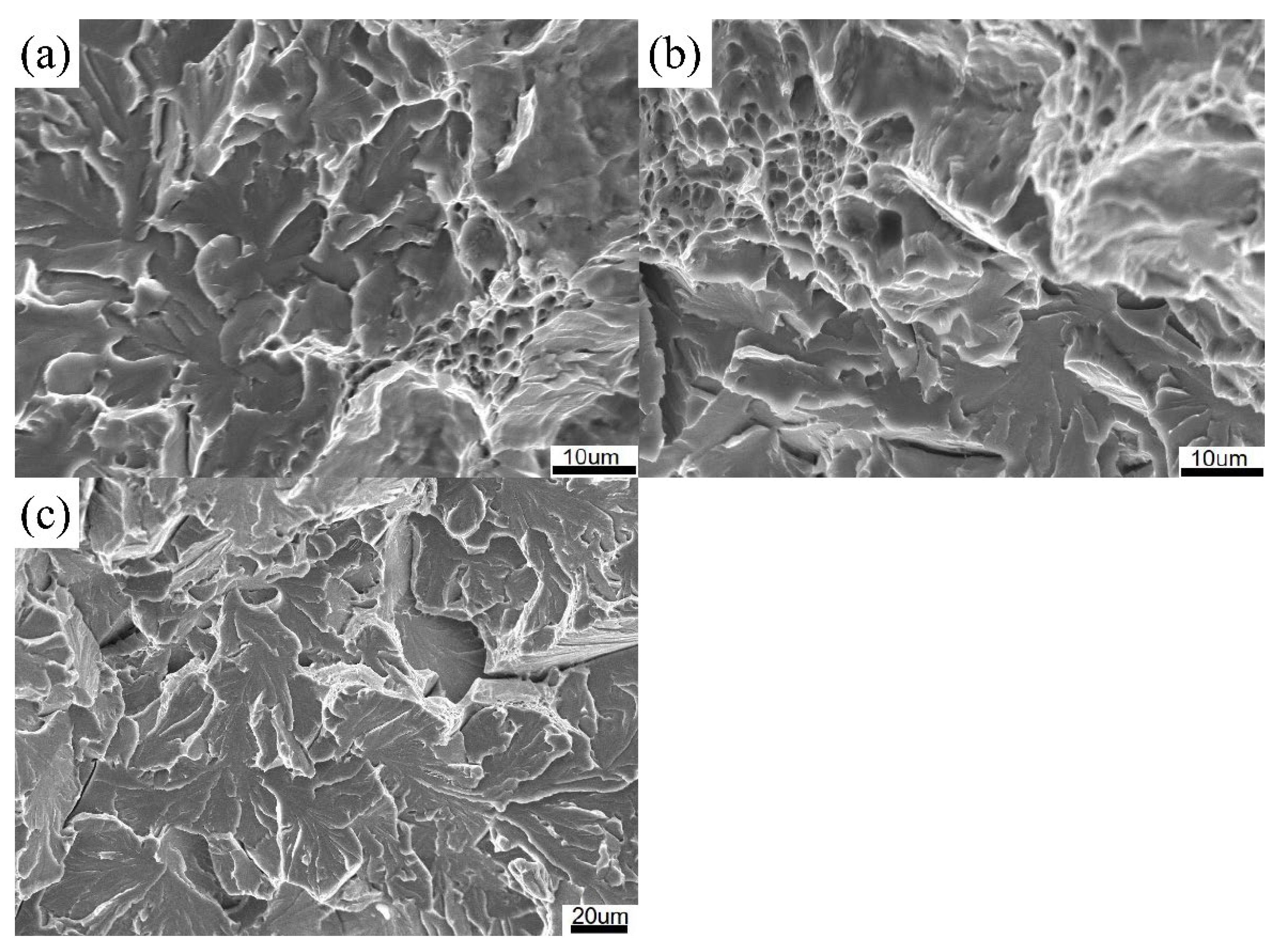





| C | Si | Mn | P | S | Nb | V | Ti | Cr | Ni | Cu | Mo |
|---|---|---|---|---|---|---|---|---|---|---|---|
| 0.10 | 0.22 | 1.06 | 0.005 | 0.002 | 0.03 | 0.07 | 0.003 | 0.29 | 1.0 | 0.09 | 0.39 |
| Heating Temperature (°C) | Push Speed (mm/s) | Cooling Water Flow (m3/h) | Bending Angle (°) | Tempering Temperature (°C) | Holding Time (min) | Cooling |
|---|---|---|---|---|---|---|
| 1050 | 0.3 | 50 | 4 | 580 | 90 | Air Cooling |
| Samples | Total Absorbed Energy (J) | Crack Initiation Energy (J)/Percentage | Crack Propagation Energy (J)/Percentage |
|---|---|---|---|
| S1 | 174 | 70 (40.2%) | 104 (59.8%) |
| S2 | 185 | 67 (36.2%) | 118 (63.8%) |
| S3 | 109 | 65 (59.6%) | 44 (40.4%) |
| Samples | HAGBS | LAGBS |
|---|---|---|
| S1 | 41.1 (%) | 58.9 (%) |
| S2 | 38.3 (%) | 61.7 (%) |
| S3 | 29.5 (%) | 70.5 (%) |
Publisher’s Note: MDPI stays neutral with regard to jurisdictional claims in published maps and institutional affiliations. |
© 2021 by the authors. Licensee MDPI, Basel, Switzerland. This article is an open access article distributed under the terms and conditions of the Creative Commons Attribution (CC BY) license (https://creativecommons.org/licenses/by/4.0/).
Share and Cite
Hu, J.; Liu, Y.; Wang, G.; Li, Q. Effects of Microstructure on the Low-Temperature Toughness of an X80 × D1422 mm Heavy-Wall Heat-Induced Seamless Bend. Metals 2021, 11, 1055. https://doi.org/10.3390/met11071055
Hu J, Liu Y, Wang G, Li Q. Effects of Microstructure on the Low-Temperature Toughness of an X80 × D1422 mm Heavy-Wall Heat-Induced Seamless Bend. Metals. 2021; 11(7):1055. https://doi.org/10.3390/met11071055
Chicago/Turabian StyleHu, Juntai, Yu Liu, Ge Wang, and Qiang Li. 2021. "Effects of Microstructure on the Low-Temperature Toughness of an X80 × D1422 mm Heavy-Wall Heat-Induced Seamless Bend" Metals 11, no. 7: 1055. https://doi.org/10.3390/met11071055






